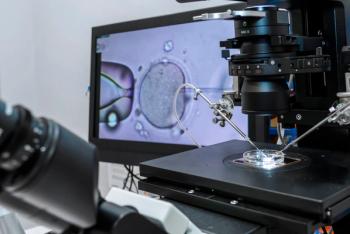
Laparoscopy
Laparoscopy, looking inside the abdomen through a tube placed through a small incision, is a procedure commonly used by gynecologists to diagnose and treat a number of medical conditions. Since the early 1900's when rudimentary laparoscopes were used to visualize, but not treat, abdominal diseases, advancements in this technique have led to the ability to perform complex surgical procedures through a few small incisions, rather than the larger incisions used in the past.
Laparoscopy, looking inside the abdomen through a tube placed through a small incision, is a procedure commonly used by gynecologists to diagnose and treat a number of medical conditions. Since the early 1900's when rudimentary laparoscopes were used to visualize, but not treat, abdominal diseases, advancements in this technique have led to the ability to perform complex surgical procedures through a few small incisions, rather than the larger incisions used in the past.
Laparoscopy is usually performed through a small (1 centimeter) incision into the belly button with the patient under general anesthesia in the operating room. A camera is mounted to a long tube about as big around as one's first finger, which is placed into the incision in the belly button and into the abdominal cavity. Once inside carbon dioxide gas is used to expand the abdominal cavity so the internal organs can be visualized. The gynecologist either looks through the tube, or, more commonly, looks at a video monitor via the attached camera. A careful survey is made of the liver, appendix, the top layer of intestines, bladder, kidney tubes (ureters), and the gynecologic organs. Specifically, the gynecologic surgeon is able to fully visualize the uterus (womb), ovaries, fallopian tubes, rectum, and the bottom part of the cervix (the opening to the uterus) called the cul-de-sac. As one might imagine, this technique allows gynecologists to diagnose a large variety of important medical conditions.
If treatment is necessary one or more smaller incisions can be made near the bikini line, each measuring only 5 millimeters (less than a pencil eraser). Long instruments are placed through these incisions so that tissue can be cut, grasped, removed, or burned. Specialized instruments such as sterile plastic baggies, retractors, or lasers can also be used through these incisions. The gynecologist and operating room staff then perform the surgery by moving the instruments by "hand-eye coordination" while watching the video monitor. Obviously, it takes some practice to do this type of surgery, since one can only touch the tissues from a distance, using the small, long instruments. Some physicians are now performing "office laparoscopy" using even smaller scopes and instruments on patients who are under light sedation in the office. This is still considered somewhat experimental by most gynecologists, and while this type of surgery may turn out to be safe, there are obvious safety concerns when performing complex surgery in a doctor's office, and not the hospital or a fully-equipped outpatient surgical center.
Gynecologists use laparoscopy to treat a variety of female health problems. General surgeons also now use laparoscopy to perform surgeries such as appendectomies and removal of the gall bladder (cholecystectomy). Indications for gynecologic laparoscopy include the following:
Pelvic pain.
Infertility.
Endometriosis.
Tubal ligation (tying tubes).
Tubal (ectopic) pregnancies.
Pelvic inflammatory disease.
Repairing damaged fallopian tubes.
Lysis of adhesions (removing scar tissue).
Laparoscopic assisted vaginal hysterectomy.
Removal of ovarian cysts or the entire ovary.
Evaluation and removal of pelvic lymph nodes.
Diagnosis and treatment of some uterine anomalies.
Destroying or removing some uterine fibroid tumors.
The decision to perform a laparoscopic procedure (versus using non-surgical treatment or using a larger scar for the planned surgery) is a very individual issue that requires close consultation between the patient and her physician. Laparoscopy is almost always an "outpatient" procedure, meaning patients feel well enough to go home the same evening as their surgery. However, some procedures are more involved and will require an overnight stay in the hospital. Furthermore, even though complications are generally unusual, laparoscopy is still a surgical procedure (to paraphrase an esteemed colleague of mine: "minor procedures are ones you perform on someone else"!). All surgical procedures have potential complications. Some potential complications from laparoscopy include damage to the intestines (particularly while putting in the gas to expand the abdomen), nicking of blood vessels (especially hidden vessels under the skin of the abdomen), damage to the bladder or kidney tubes, which may require additional surgical procedures to repair, and damage or scarring of the gynecologic organs, which may create fertility problems in the future. Finally, due to the complexity of such procedures, some laparoscopic procedures may require conversion into a much larger procedure, called a "laparotomy" which entails making a large incision into the abdomen to either fix a medical problem that cannot be tackled via laparoscopy, or fix a complication that has occurred during the laparoscopic procedure. As always, medical treatments are individual and rarely perfectly straightforward. As part of the important informed consent process a patient (and her family, if she wishes) need to sit down with the doctor and discuss the risks and benefits of each planned procedure. Physicians need to remember that sometimes patients have a different impression of surgical procedures than doctors. Thus education and an honest assessment of the risks and benefits is necessary. Patients should keep in mind that despite the best efforts of the doctor, and despite his or her skills, sometimes complications can occur during surgical procedures. Simply put, there is always a balance between the potential benefits of having a surgical procedure performed and the potential chance of complications that might occur from that procedure.
After laparoscopy most patients go home that evening with a prescription for pain medications and advise to "take it easy" for about a week. Each patient will heal differently. Many women report shoulder pain due to the gas used to distend the abdomen. Others note pain at the incision sites, while others feel sharp or aching pains deep in the pelvis (above the vagina) due to inflammation from healing tissues that have been manipulated or cut during surgery. All of these are normal, and can be relieved by appropriate use of pain medications, heating pads, and rest. Most gynecologists advise against driving, exercise, sex, or heavy lifting for 1-2 weeks. I have seen patients golf within 3 days of a laparoscopic vaginal hysterectomy while others are unable to venture outside of the house for a week after the same procedure. Healing is a very individual process! Before leaving the hospital a patient should be comfortable with the directions she receives from her nurses and doctor. Also, she should have access to her doctor's answering service number, and should report any of the following symptoms immediately: an expanding bruise under an incision (this may be due to a blood clot, or hematoma, under the skin), recurrent vomiting, fever, or abdominal distention (may be due to intestinal damage), heavy bleeding through the vagina (spotting is common and usually harmless), pain that worsens despite pain medication, and severe flank (kidney) pain, which may alert your doctor to kinking or damage to one of the tubes that comes from the kidney to the bladder.
In summary, laparoscopy is a wonderful tool for performing gynecologic surgery. Yet, despite the complexity of the surgery, most women go home without difficulty the same day. Whether or not laparoscopic surgery is advisable to diagnose or treat a particular gynecologic problem requires a careful consultation with an experienced gynecologist, who can help the patient weigh the pros and cons of laparoscopy versus other options.
Newsletter
Get the latest clinical updates, case studies, and expert commentary in obstetric and gynecologic care. Sign up now to stay informed.
















